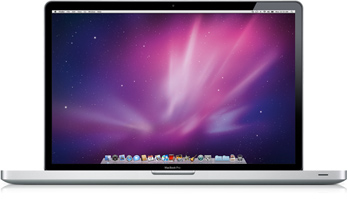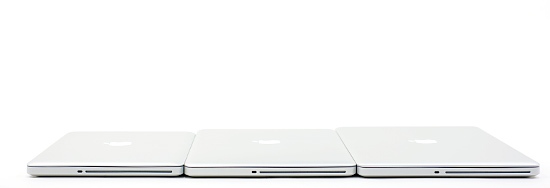Done for 2009: The Holiday MacBook Pro Roundup
by Anand Lal Shimpi on November 10, 2009 12:00 AM EST- Posted in
- Mac
And The Story Begins
Traditionally the notebooks with the largest screens are the least attractive, have the worst battery life and are heavy. They're also usually cheaper than their smaller brethren to give people a reason to buy them.
Take a look at what Dell and HP offer with a 17-inch screensize:
| 17.3-inch Notebooks | Dell Studio 17 | HP Pavillion dv7t Quad Edition |
| CPU | Intel Core i7 720QM (1.6GHz, up to 2.8GHz Turbo) | Intel Core i7 720QM (1.6GHz, up to 2.8GHz Turbo) |
| Memory | 4GB DDR3-1066 | 4GB DDR3-1066 |
| HDD | 250GB 7200RPM | 320GB 7200RPM |
| Video | ATI Mobility Radeon HD 4650 1GB | NVIDIA GeForce GT 230M 1GB |
| Optical Drive | 8X Slot Load DL DVD +/-R | 8X Slot Load DL DVD +/-R |
| Screen Resolution | 1600 x 900 | 1600 x 900 |
| Battery | 9-cell 85Whr | 8-cell ??WHr |
| Dimensions (W x D x H) | 16.28" x 11.04" x 1.1" - 1.54" | 16.2" x 10.9" x 1.37" - 1.70" |
| Weight | 7.08 lbs (6-cell battery) | 7.74 lbs |
| Price | $1099 | $1069.99 |
In both cases you're looking at over 1" thick at the thinnest point, and in the case of the HP system it goes up to 1.7" thick. Both machines start at 7 lbs and don't offer higher than 1080p resolutions. In fact, all the larger screen is useful for is reducing DPI as you can get the same resolution screen in 15-inch and 16" models. The hardware is usually fast and affordable, both machines cost less than $1000.
The 17-inch MacBook Pro is a bit different.

At 0.98" thick, it's only 0.03" thicker than the 13-inch or 15-inch MacBook Pro. And that's a constant thickness from front to back. The impact on how it feels is tremendous. It's the first 17-inch notebook I've used that doesn't make me want to laugh at first sight. It honestly just looks and feels like a slightly bigger 15-inch machine.
| 17.3-inch Notebooks | Apple 17-inch MacBook Pro | HP Pavillion dv7t Quad Edition |
| CPU | Intel Core 2 Duo 2.8GHz | Intel Core i7 720QM (1.6GHz, up to 2.8GHz Turbo) |
| Memory | 4GB DDR3-1066 | 4GB DDR3-1066 |
| HDD | 500GB 5400RPM | 320GB 7200RPM |
| Video | NVIDIA GeForce 9400M (integrated) + NVIDIA GeForce 9600M 512MB (discrete) | NVIDIA GeForce GT 230M 1GB |
| Optical Drive | 8X Slot Load DL DVD +/-R | 8X Slot Load DL DVD +/-R |
| Screen Resolution | 1920 x 1200 | 1600 x 900 |
| Battery | 95Whr | 8-cell ??WHr |
| Dimensions (W x D x H) | 15.47" x 10.51" x 0.98" | 16.2" x 10.9" x 1.37" - 1.70" |
| Weight | 6.6 lbs | 7.74 lbs |
| Price | $2499 | $1069.99 |
It’s also Apple’s most expensive notebook. Starting at $2499, it’s more expensive than the 27” iMac and doesn’t even come with a quad-core processor. You’re paying for the screen size, as you can get the same hardware in the 15” MacBook Pro.
The added size is used for one purpose: a higher screen resolution. Apple offers a single display option with the 17-inch machine: a native 1920 x 1200 panel. It's a 16:10 aspect ratio panel, measuring 17-inch on the diagonal, resulting in a pixel density of 133.2 pixels per inch (PPI).
| 17.3-inch Notebooks | Pixels per Inch |
| Apple 13-inch MacBook Pro | 113.5 |
| Apple 15-inch MacBook Pro | 101.6 |
| Apple 17-inch MacBook Pro | 133.2 |
| Apple 27-inch iMac | 108.8 |
| Apple 30-inch Cinema Display | 101.6 |
| 15-inch 1080p Panel | 141.2 |
That’s more than a 30” display. That's more than the 27" iMac. That's more than any other 17-inch notebook on the market today. Only the 15-inch 1080p panels offer a higher pixel density at 141.2 PPI. It's sharp.
Apple makes the 17-inch MacBook Pro very work-focused, you get a ton of desktop space in a package that's honestly not bulky. I can't stress how pleasant it is to carry around; at a constant thickness of less than 1" it really feels a lot smaller than it is. It's the only 17-inch notebook I'd be willing to take with me.

From left to right: 13-inch, 15-inch, 17-inch MacBook Pro. Note the constant height.
The 17-inch MacBook Pro was the first to use Apple's integrated batteries out of necessity. Apple wanted to build a slim, attractive 17-inch MacBook Pro, and cutting down on battery volume enabled that. A side effect was that the 17-inch model has impressive battery life.
Paired with a 95Whr battery, Apple promised up to 8 hours of battery life - a realistically attainable figure as you'll soon see.
From a hardware perspective the 17” isn’t that much different from the rest of the lineup. The system starts with a NVIDIA GeForce 9400M chipset, adds a separate GeForce 9600M for GPU intensive workloads (3D games, OpenCL apps, etc...) and gives you the option of either a 2.8GHz or 3.06GHz 45nm Core 2 Duo with a 6MB L2 cache. The vast majority of users will find the 9400M is sufficient for their needs. And paired with Snow Leopard, the 9600M in the off state doesn’t sap as much battery power as it did under Leopard.
The machine starts with 4GB of memory, expandable up to 8, and comes with a 500GB 5400RPM SATA drive. SSDs are still only optional from Apple.
The 17” system doesn’t come with an integrated SD card reader but it is the only MacBook Pro to ship with an ExpressCard/34 slot.

From left to right: Power input, Ethernet, FireWire 800, 3 USB, Mini DisplayPort, Line In, Headphone Out, ExpressCard/34
Mini DisplayPort is the only way to connect to an external display, and unfortunately Apple cheeps out and doesn't supply any adapters with the machine. With a 17-inch 1920 x 1200 panel, you'll probably be fine without one though.
About the only thing that the machine is missing is Nehalem, but that won't come until next year.

From left to right: 13-inch, 15-inch and 17-inch MacBook Pro
The 17” MacBook Pro started a new trend within Apple. Integrate the battery, offer longer battery life and no one will complain. The technology soon waterfalled down to the 15” and 13” models.










115 Comments
View All Comments
Drakino - Wednesday, November 11, 2009 - link
I'd be curious to know what battery life is like playing back H.264 content, since it should be accelerated by the GPU. Would help to know if it's worth the effort to encode to it over any other format.Ram21 - Wednesday, November 11, 2009 - link
You could do another benchmark on the Mac systems with Blender 3d. It would give you a comparison to the PCs with similar specs.Great Article, thank you.
drew952 - Wednesday, November 11, 2009 - link
Could somebody clear up my confusion please...The article states "Both machines start at 7 lbs and don't offer higher than 1080p resolutions." However, in the specifications for said computers, the resolution is 1600 x 900.Isn't that comparable and/or better then 1080p?
slashbinslashbash - Wednesday, November 11, 2009 - link
1080p is 1920x1080. So it is substantially higher resolution than 1600x900. (2.07 million pixels vs. 1.44 million pixels)FYI, 720p is 1280x720, so even the 13" MBP with the 1280x800 screen resolution handles 720p.
The0ne - Wednesday, November 11, 2009 - link
Just wondering if you guys have a Droid 2 review coming for 2009? Would like you guys to do this so we can have the Pre, Droid and Iphone for comparison. Thanks.crimson117 - Wednesday, November 11, 2009 - link
"Jarred has seen similar results. One of his battery life tests involves leaving the laptop idle at the Windows desktop until it shuts off."That sounds like Anand caught Jarred napping at his workstation, and Jarred was like "no, really I'm, uh, testing battery life! See? It's my custom made Idle Windows Desktop Battery Life Test."
I'm going to start testing my software designs by observing to make sure they don't alter themselves if left untouched on my computer for 6 hours ;)
DCstewieG - Wednesday, November 11, 2009 - link
Anand, you say you want a more forward looking test for watching videos and then you use XviD? Surely you know how to use Handbrake. Then you could show battery life watching H.264 videos in QuickTime with GPU acceleration.Otherwise great article! You first Mac article way back when got me first seriously looking at Macs and now I've been a happy MBP owner for 2 years. Thanks!
Pneumothorax - Wednesday, November 11, 2009 - link
It's about time somebody from the press brings up the cursed SSD Macbook Pro issue. Even some of the 15" MBP 2009 models with the 1.7 Sata II patch are still having random freezes with Intel 160gb G2 SSD's. It drove me so crazy that I returned a 2009 MBP and got a refub 2.53 MBP 2008 with the removable battery. Now my G2 runs flawlessly. Whenever there's a hardware issue, Apple likes to give us the silent treatment (which is MUCH WORSE than the spokesholes remarks that pc makers will at least give you) Shame on you Apple!The0ne - Wednesday, November 11, 2009 - link
You'll like their terminology of their latest patch for the OS then :)http://www.dailytech.com/Apple+Releases+OS+X+1062+...">http://www.dailytech.com/Apple+Releases+OS+X+1062+...
SmCaudata - Wednesday, November 11, 2009 - link
I have an early 2008 MBP. I'll not buy an apple machine again. Their updates are so infrequent that when there is a problem like the terrible batter life or wireless issues with Snow Leopard you have to wait for a year for it to be fixed. Instead they spend time "fixing" iTunes to make it not work with the Palm Pre (I don't own a Pre...I just think them repeatedly disabling it is getting old).With new windows7 laptops like that 14" Acer Anand reviewed a few weeks ago, I expect Apple is going to have to stop being so closed off. What's more I could buy a new PC laptop every year for the same out of pocket cost to get a MacBook every 3 years. I still need boot camp on my MPB for some programs and there is nothing on my MacOS that I cannot have on Win7.
So long Apple... Fool me once....